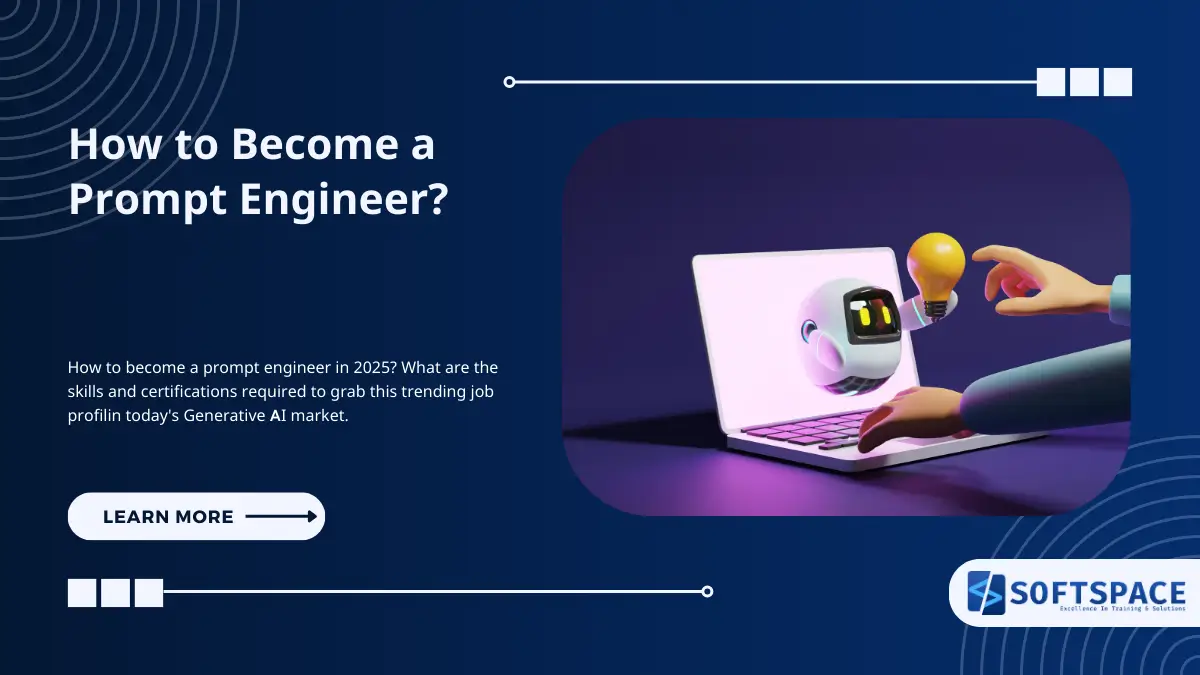Prompt engineering is a pivotal skill in the age of artificial intelligence, enabling effective communication with AI models. This guide delves into the essentials of how to become a prompt engineer, covering key skills, tools, and career opportunities.
- What is prompt engineering?
- What do you need to get started?
- What are the top skills, certifications, and salary ranges?
- How can you become a prompt engineer step by step?
Follow our roadmap to launch your AI career as a prompt engineer.
Job postings for prompt engineers have increased by over 200% in the last year. This surge shows why learning prompt engineering could place you in the vanguard of technology’s most rapidly expanding fields.
Prompt engineering emerged with generative AI as a new discipline. It helps professionals craft instructions that guide AI systems toward desired outputs. The generative AI industry will reach $356.10 billion by 2030.
Companies of all sizes need prompt engineers for customer service, content creation, and marketing. Prompt engineers in India earn between ₹15 lakhs and ₹39 lakhs annually. Senior roles can command upwards of ₹50 lakhs.
Would you like to reshape your career next in the coming months? Let’s take a closer look at “how to become a prompt engineer in today’s AI-driven landscape?”.
1. What is Prompt Engineering?
Prompt engineering is the process of designing, testing, and improving prompts to interact effectively with AI models, such as ChatGPT or Google Gemini.
Key takeaway: Prompt engineers help AI models deliver better, reliable answers.
2. Why is Prompt Engineering a Top Career in 2025?
- Rapid growth in AI adoption (chatbots, automation, business intelligence)
- High demand for prompt optimisation experts
- Attractive salaries, even for entry-level roles
- AI literacy is becoming essential for all tech jobs
Key takeaway: Prompt engineering is a future-proof skill with global relevance.
3. What Does a Prompt Engineer Do?
Typical responsibilities:
- Design, test and refine prompts for large language models (LLMs)
- Collaborate with data scientists, developers, and product teams
- Develop prompt-based solutions for internal tools, customer support, and content generation
- Analyse prompt quality and model responses for accuracy
4. How to become a Prompt Engineer in 2025?
- Technical Skills
- Understanding of LLMs (e.g., ChatGPT, Gemini)
- Experience with Python or similar programming languages
- Familiarity with APIs and AI tools
- Soft Skills
- Critical thinking and problem-solving
- Communication and collaboration
- Creativity in designing prompts
- Attention to detail
Tip: Add strong English writing/editing skills to improve AI communication.
5. Certifications & Courses for Prompt Engineers
| Certification | Provider | Duration |
|---|---|---|
| Prompt Engineering for AI | Coursera/DeepLearning.AI | 4 weeks |
| Generative AI with LLMs | Google/Coursera | 6 weeks |
| OpenAI API Bootcamp | OpenAI/LearnPrompting | 2 weeks |
| Introduction to Natural Language AI | Udacity | 6 weeks |
| Applied AI: Prompt Design | edX | 5 weeks |
Key takeaway: Choose a course with hands-on projects for better learning.
6. Average Prompt Engineer Salary (2025 Update)
| EXPERIENCE | APPROXIMATE SALARY RANGE (INR) |
| Entry Level (0 to 4 years) | 5 lakhs to 6.6 lakhs |
| Intermediate (5 to 9 years) | 14.3 lakhs to 16 lakhs |
| Senior Professional (10- 15 years) | 18 to 35 lakhs |
Average salary is ₹33.5lakhs. Employees who have mastered and work on Prompt Engineering earn an average of ₹33.5lakhs, ranging from ₹19.5lakhs to ₹162 lakhs based on 126 profiles. Source: 6figr.com
| CITY | AVERAGE ANNUAL SALARY (INR) |
| New Delhi | 5.62 lakhs |
| Pune | 5.96 lakhs |
| Bengaluru | 10 lakhs |
| Mumbai | 6.38 lakhs |
| Chennai | 5.7 lakhs |
| Kolkata | 4.82 lakhs |
What are the highest paying jobs in Prompt Engineering?
The top 5 highest paying jobs in Prompt Engineering with salaries are:
- Software development engineer – ₹125.0lakhs per year
- Software engineer – ₹61.0lakhs per year
- Independent consultant – ₹57.0lakhs per year
- Data scientist – ₹55.0lakhs per year
- Lead data scientist – ₹52.0lakhs per year
- Note: Actual salaries vary based on company, location, and experience.
- Source: LinkedIn, Glassdoor, Naukri (2025)
7. Step-by-Step Guide: How to Become a Prompt Engineer?
Week 1–2: Basics
- Learn about AI, natural language models, and prompt engineering fundamentals.
Week 3–4: Skill Building
- Practise designing simple prompts using ChatGPT or free online tools.
- Start learning Python if you don’t already know it.
Week 5–8: Advanced Practice
- Enrol in an online prompt engineering certification.
- Work on practical projects—redesign chatbot replies, automate responses, etc.
Month 3: Build a Portfolio
- Document your best prompts and solutions on GitHub.
- Write blog posts or share case studies.
Month 4: Apply for Roles
- Update your resume and LinkedIn profile with relevant skills and certifications.
- Start applying for prompt engineer and AI product specialist roles.
Bonus:
- Join AI communities (Discord, LinkedIn groups).
- Stay updated with prompt engineering trends by following industry blogs.
Key takeaway: Consistency and practice, not just theoretical knowledge, will set you apart.
8. Top Companies Hiring Prompt Engineers (2025)
- OpenAI
- Microsoft
- Infosys
- TCS
- Accenture
- Startups in AI automation and EdTech
Tip: Also explore freelance gigs and contract roles in international markets.
Conclusion
“Becoming a prompt engineer offers exciting opportunities in the evolving field of AI. By acquiring the necessary skills and staying updated with industry trends, you can position yourself at the forefront of AI innovation.”
9. Frequently Asked Questions (FAQs)
Q1: What degree do I need to become a prompt engineer?
A: Most roles require a bachelor’s degree in computer science or a related field. However, a strong AI portfolio and certifications can substitute for formal degrees.
Q2: Can non-programmers get into prompt engineering?
A: Yes—creativity, language skills, and understanding AI behaviour are just as important. Learning basic Python helps.
Q3: What’s the future of prompt engineering?
A: As AI advances, prompt engineering will grow into prompt architecture and hybrid human+AI roles.

13+ Yrs Experienced Career Counsellor & Skill Development Trainer | Educator | Digital & Content Strategist. Helping freshers and graduates make sound career choices through practical consultation. Guest faculty and Digital Marketing trainer working on building a skill development brand in Softspace Solutions. A passionate writer in core technical topics related to career growth.

